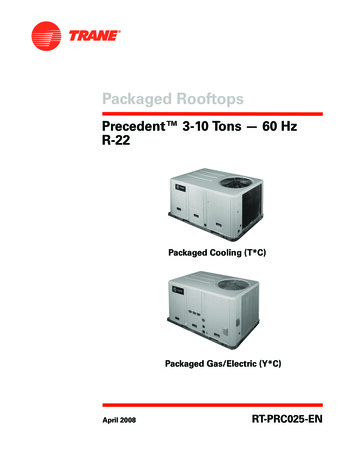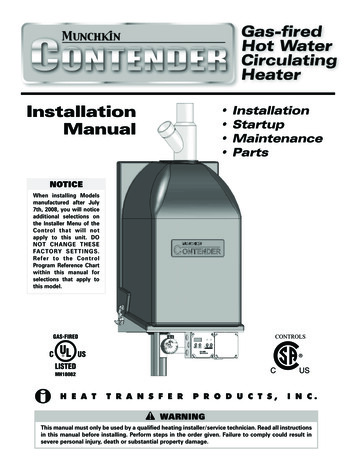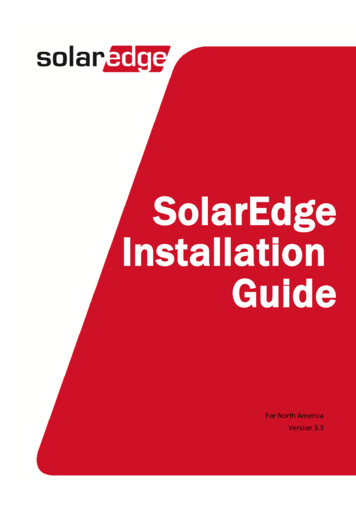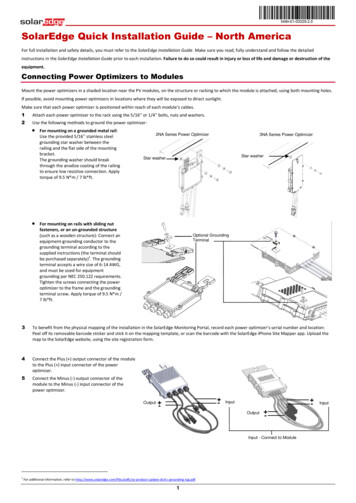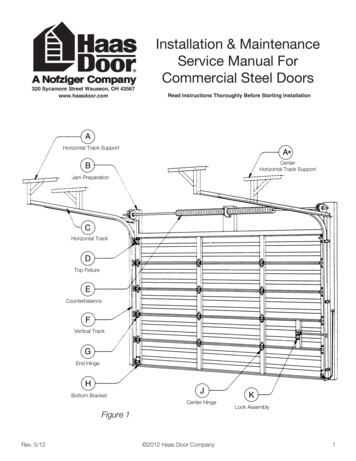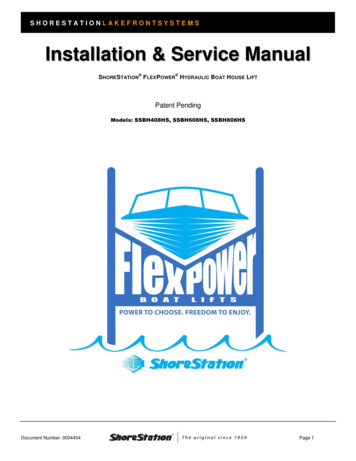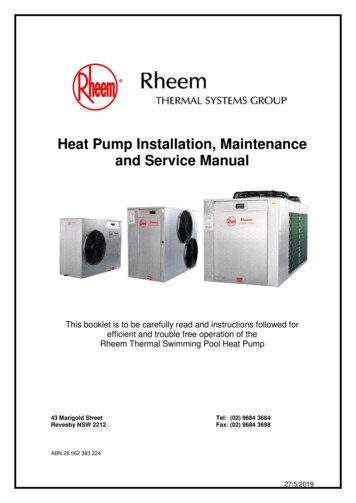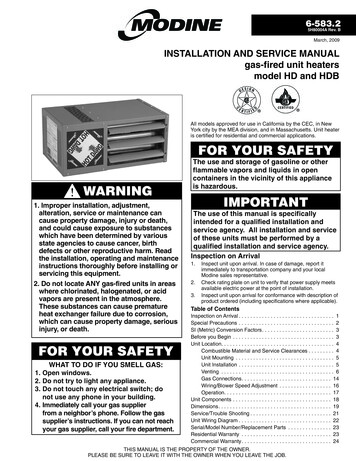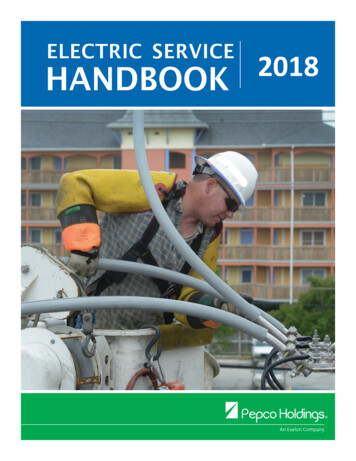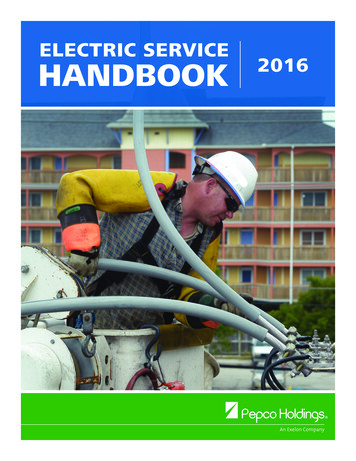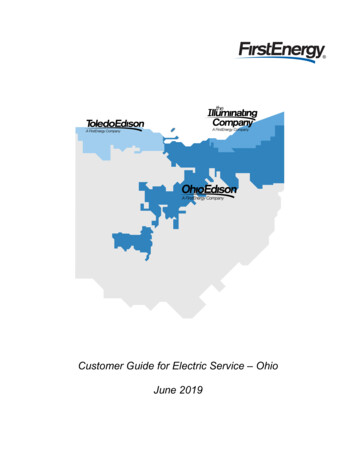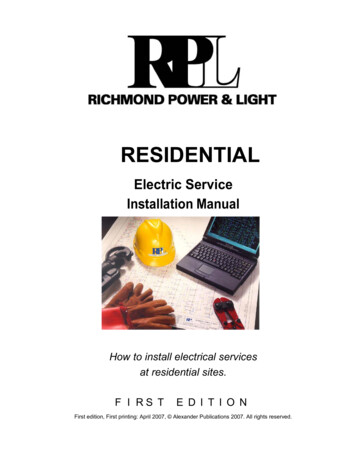
Transcription
RESIDENTIALElectric ServiceInstallation ManualHow to install electrical servicesat residential sites.F I RS TE D I T I O NFirst edition, First printing: April 2007, Alexander Publications 2007. All rights reserved.
ContentsChapter 1 Introduction.Residential Service .Temporary Service.Chapter 2 Overhead Services.Overhead Line Clearances .Check List for Installing Overhead Service .Service Mast, Surface-Mount Meter .Service Mast, Flush-Mount Meter .Overhead Service, Meter Pole.Temporary Overhead Service, Meter Post .Chapter 3 Underground Services .Check List for Installing Underground Service .Locating Underground Utilities.Trenching .Underground Service, Surface-Mount Meter .Underground Service, Flush-Mount Meter.Underground Service, Pedestal Meter.Underground Service, Free-Standing Steel-Post .Underground Service, Meter Post.Transformer Installations .Safety Clearances Around Transformers .Work Clearances Around Transformers .Guard Posts .Chapter 4 Meter Installations .Chapter 5 Customer Service.Office Hours .FAX Application Deposits .Paying Your Bill.Partial Payments / Payment Agreements. .Community Assistance RP&L Fees Glossary .
CHAPTER1IntroductionInstalling new electric service is a joint project between the customer and thepower company. The power company is responsible for bringing power to thesite, for installing the meter in the socket provided by the customer, and for energizing the service. The customer is responsible for obtaining permits and inspections, providing and maintaining the overhead path or underground trench for thepower company’s wires, and for installing the equipment at the service entrance.Residential ServiceResidential service is defined as service to a single-family residence. Service to amulti-family residence such as an apartment or condominium is a business service.Voltage for residential services is 120/240 volts, except for special situations.Services up to 400 amps are single-phase.Current RatingTypical UseCommentLess than 200 ampsSmall homesSee Note 1, below200 ampsMedium homesThe most common service400 ampsLarge homesOver 400 ampsVery large homes See Note 2, belowNote 1. 200 amps is the minimum service installed by the power company. If theload is less than 200 amps and the service is overhead, the meter socket andservice panel may be rated at less than 200 amps. If the load is less than 200amps and the service is underground, the meter socket and service panel mustbe rated at 200 amps.Note 2. Services over 400 amps are three-phase. These installations are addressed on an individual basis.Table 1-1. Typical residential services.
Temporary ServiceTemporary service is defined as electric service to a site for less than one year.The most common use of temporary service is to deliver power during the construction phase of a project. When the project is complete, the temporary serviceis replaced by permanent service.Temporary services are usually 120/240 volts, single-phase, 200 amperes.Customers receiving service at primary voltage may own poles, conductors,
CHAPTER2Overhead ServiceThe cost for overhead service depends on the extent of special engineering required. The least complicated and cheapest situation is when a transformer is ona pole on, or near the property. If this is the case, engineering may not be required. The customer simply installs the service entrance equipment, has it inspected, and calls the utility to have service connected.The customer is responsible for providing, installing, and maintaining all equipment from the point of delivery except for the meter.The power company is responsible for providing and installing the meter, completing the connections between the meter and the service conductors, and making the final connections at the point of delivery.Figure 2-1. Features of an overhead service.Figure 2-1 shows a finished installation of overhead service, using a servicemast. The customer provides everything shown here, except the meter, the overhead service line, and the power pole and pole-mounted equipment.After the customer installs the required equipment, the power company installsthe meter in the meter socket, strings the service line, attaches the service linesupporting wire (neutral) to the insulated clevis, and splices the conductors together.
Overhead Line ClearancesFigure 2-2. Clearances from ground.Figures 2-2 and 2-3 show clearances under overhead lines, for the conditionsmost commonly encountered. For other situations and for details, see the National Electric Code, the National Electrical Safety Code, or contact the electricalinspector for your area.The customer does not string the service conductor, but is required to provide apoint of attachment high enough and strong enough, to allow the utility to installthe service line and maintain the required clearances.If the span of the service line exceeds 125 feet, an intermediate support polemay be required to relieve the tension on the service mast.Figure 2-3. Clearances over other structures.
Avoid a route for the service line that passes over a driveway. Lines which crossdriveways can be struck by tall trucks and other vehicles, causing damage to theservice equipment and to the building. If the service line will pass through trees,the customer must prune the trees to provide a clear path for the line. The customer is also responsible for regular tree pruning, and if necessary, tree removalto keep the path clear. If the service line will pass over brush, the customer mustclear a path for the power company’s installation service personnel.Figure 2-4. Overhead service clearances over swimming pools.
Service Mast, Surface-Mount MeterFigure 2-5. Surface mounted meter installation.Figure 2-5 shows details of a service mast, with the meter on the surface of thebuilding. The service could be wired to an exterior meter as shown here, or toservice equipment inside the building. The customer installs everything in the picture, except the meter.After the customer installs the service equipment, the power company installs themeter in the meter socket, strings the service line, attaches the service line supporting wire (neutral) to the insulated clevis, and splices the conductors together.
Service Mast, Flush-Mount MeterFigure 2-6. Flush-mount meter installation.Figure 2-6 shows the details of a service mast, with the meter mounted flush withthe surface of the building. Flush-mount meters are sometimes installed for aesthetic reasons. The service could be wired to an exterior meter as shown here, orto service equipment inside the building.
Overhead Service, Meter PoleFigure 2-7. Overhead service to a pole.In Figure 2-7, the service is overhead from the power company to the pole. Fromthe pole, the service could be overhead to the building, or underground as shownhere.
Temporary Overhead Service, Meter PostFigure 2-8. Temporary overhead service.Figure 2-8 shows a finished installation for temporary service, using a meter post.The service is overhead from the power company to the post. From the post, theservice to the building could be overhead or underground.
CHAPTER3Underground ServiceThe cost for underground service depends on the extent of special engineeringrequired. The least complicated and cheapest situation is if a padmount transformer, stubout, or access hole is already on the property. If this is the case, engineering may not be required. The customer simply installs the service entranceequipment, has it inspected, and calls the utility to have service connected.Check List for Installing Underground ServiceCUSTOMER RESPONSIBILITY1. Contacts the utility to discuss the project, to determine where the service linewill originate from and the point of delivery, and to request the service.2. If requested, provides the power company with: Site drawings Load information An easement for permanent equipment owned by the power companyand installed on the customer’s property Payment for pre-construction costs3. Obtains permits and inspections.4. Contacts City or County Inspector for final Inspection.5. Signs for new electrical service at RP&L Customer Service Office.UTILITY RESPONSIBILITY1. RP&L provides trench for underground (fees may apply).2. Makes the final connection at the point of delivery. Must be inspected by Cityor County Inspector.
Locating Underground UtilitiesThe customer must call (Call - 411 for Indiana Dig) the underground utilitieslocating service at least two full working days (48 hours) before trenching or excavating for underground service. One call to the locating service notifies all utilities that locates are required. In some areas, not all utilities are members of theone-call system. In those areas, the customer must contact each utility individually.Do not begin excavation until the locations of underground wires, cables, andpipes have been marked, or the utilities have informed the customer that theyhave no facilities in the area.Any digging within 24 inches of location marks must be done by hand.The color code for marking underground utilities is:ColorUnderground ServiceRedElectricYellowGas, Oil, SteamOrangeTelephone, Cable TVBlueWaterPurpleReclaimed waterGreenSewerPinkTemporary survey marksWhiteProposed excavationTable 3-1. Color code for marking underground services.TrenchingRichmond Power & Light digs their own trench for underground services (feesmay apply). Contact Richmond Power & Light Engineering (765) 973-7203
Underground Service, Surface-Mount MeterFigure 3-4. Underground service to a surface-mount meter.Figure 3-4 shows a finished underground installation with the meter on the surface of a house.The service is underground from the power company to a stubout, handhole, orpadmount transformer (off to the left and not shown here). Conductors placed inthe trench bring the power to the conduit at the base of the service entrance.
Underground Service, Flush-Mount MeterFigure 3-5. Underground service to a flush-mount meter.Figure 3-5 shows a finished underground installation with the meter mountedflush with the surface of the building. Flush-mount meters are sometimes installed for aesthetic reasons.The service is underground from the power company to a stubout, handhole, orpadmount transformer (off to the left and not shown here). Conductors placed inthe trench bring the power to the conduit at the base of the service entrance.
Underground Service, Pedestal MeterFigure 3-6. Underground service to a pedestal meter.A meter pedestal is a free-standing factory-built structure that supports serviceequipment for underground service. It is most commonly used with manufacturedhomes. If a meter pedestal is called for, it is the customer’s responsibility to purchase and install it.Install the meter pedestal between the home and normal public access, and within 30 feet of the home. The pedestal usually contains the disconnect switch required by the NEC.
Underground Service, Free-Standing Steel-PostFigure 3-7. Underground service to a free-standing steel-post structure.
Underground Service, Meter PostFigure 3-8 shows a finished installation for temporary service, using a meter post.The service is underground from the power company to a stubout, handhole, orpadmount transformer. Conductors placed in the trench bring the power to thebase of the post. From the post, the service to the building is usually underground, but could be overhead.Figure 3-8. Temporary underground service.
Transformer InstallationsThe power company is responsible for installing a padmount or submersible (totally underground) transformer at or near the customer’s site. Conductors to theprimary side of the transformer enter at the left side of the transformer; conductors to the secondary side enter at the right. The trench runs from the right side ofthe transformer to the customer’s building.The customer is responsible for installing the service conductors in the trench,from the transformer to the building.Safety Clearances Around TransformersClearances from padmount transformers to structures are measured from thenearest metal portion of the transformer, to the structure or any overhang.The clearance from a building is 3 feet if the building has non-combustible walls(brick, concrete, steel, or stone), 10 feet if the building has combustible walls (including stucco).Figure 3-9. Safety clearances around a padmount transformer.
Work Clearances Around TransformersA minimum clearance of 10 feet of clear, level working space is required in frontof a padmount transformer, to allow use of hot sticks.The clearances shown here apply to any oil-filled electrical equipment.Landscaping and other obstructions must not encroach on these clearances.Figure 3-10. Work clearances around a padmount transformer.Figure 3-11. Work clearances around an underground transformer.
Guard PostsFigure 3-12. Equipment guard post.It is the customer’s responsibility to install and maintain guard posts where powercompany equipment is exposed to vehicular traffic.Guard posts are also required where minimum clearances around equipmentcannot be met. For example: Guard posts are required where pad mounteddevices cannot be given 3 feet clearance from the back and sides of thedevice, and 10 feet from the front.If the post is placed in stable soil, surround it with 6 inches of concrete. If the soilis unstable or sand, surround the post with 12 inches of concrete.If several guard posts are used, locate them no more than 5 feet apart. For extravisibility, paint the posts traffic yellow.In some situations, a 6-inch diameter post is required, not the 4-inch post illustrated here.
CHAPTER5Customer ServiceCustomer ServiceSigning up for your electric service is easy! All you have to do is visit our Customer Service Officelocated at 44 South 8th Street. If you are unable to come into our office, we would be glad to fax ore-mail you the necessary forms.You will need to bring a photo ID, such as your driver’s license or other valid U.S. photo identification. In addition, if you are renting a property, please bring in a copy of your lease agreement. Alladults living in the household must be listed on the account. Signing up for service only takesa minute of your time. If you are signing up via fax or e-mail we ask that you send back a copy ofyour photo ID and the lease with the application form.OFFICE HOURSThe Customer Service Office is open:7:30 a.m. – 5:00 p.m. Monday through Friday
RP&L – RESIDENTIAL FAX APPLICATIONwww.RP-L.com2000 U.S. 27 SOUTHP.O. BOX 908RICHMOND, IN 47375-0908BUSINESS: 765.973.7200 FAX: 765.973.7418Please email completed form to: Cust.Service@RP-L.comDear Customer,In order to complete the “Name Change” or the transfer of service as requested, the completion of a serviceapplication is needed. This process can either be completed by visiting our office, or by fax or email.Please include a copy of your driver’s license or picture identification if you choose to fax or email theinformation to us. In addition, please include a copy of your lease with the property owner’s informationand signature if you are renting or leasing the property.Your full name:Your social security number: Phone number:Your employer:Your spouse’s name:(and/or any other adults residing in the household)Their social security number(s): Phone number:The service address:The mailing address:*(if different from service address)The effective date:If applicable provide address you are moving from and date you request services takenout of your nameYOUR SIGNATURE:SIGNATURE OF SPOUSE OR ANY/ALL ROOMMATES*Each adult needs to sign and each adult needs to include Photo Identification***Please indicate if you are the property owner:Owner?Renter?(Please circle correct option)RP&L reserves the right to use any data accessible to them in order to verify and validate residency at a specific location. We also reserve the right to runID verification and/or credit checks on all customers who have signed the application for service.Any customer signing the application takes financial responsibility for services rendered and must contact RP&L and provide the necessary documents tobe removed from an account if living arrangements change. The account balance must be current for removal of any person from the account.
DEPOSITSWill a deposit be required?New residential customers aren’t usually asked to make a deposit unless they have had previousservice with us and the account credit history requires a deposit be made. However, current customers may be asked to make a deposit if either of the two following situations apply:1. You have an unpaid Richmond Power and Light bill from a previous residence.2. Your service was disconnected due to non-payment.When a deposit is required, Richmond Power and Light will add all of the electric bills for the past12 months, then divide that total by 6.If a deposit is required, we will put the total deposit on an agreement to be paid in 3monthly installments due with your electric bill each month.Will my deposit earn interest?Yes! If your deposit is held for more than 6 months, you will earn interest at a rate of 1%per year.Will my deposit be returned?In order to have your deposit returned, you need to pay your electric bills in full, and ontime, for at least 10 of the last 12 consecutive months with no disconnect notices being issued. Once your payment record meets those guidelines, your deposit plus any interestearned will automatically be refunded to your account.If you request a disconnection of your service at your current residence, your deposit plusany interest earned w
Installing new electric service is a joint project between the customer and the power company. T
